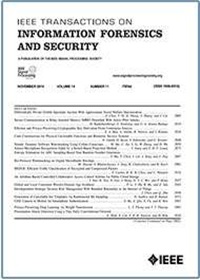通过具有优势分解特征的 Logits 混合来提高对抗性可转移性
IF 6.3
1区 计算机科学
Q1 COMPUTER SCIENCE, THEORY & METHODS
IEEE Transactions on Information Forensics and Security
Pub Date : 2024-09-20
DOI:10.1109/TIFS.2024.3465212
引用次数: 0
摘要
最近的研究表明,对抗样本具有很强的可转移性,可用于攻击其他未知的黑盒深度神经网络(DNN)。为了提高对抗样本的可转移性,人们提出了几种基于特征的对抗攻击方法,以破坏中间层的神经元激活。然而,目前最先进的基于特征的攻击方法通常需要额外的计算成本来估计神经元的重要性。为了应对这一挑战,我们提出了一种基于奇异值分解(SVD)的特征层攻击方法。我们的方法受到了以下发现的启发:从中间层特征分解出的与较大奇异值相关的特征向量表现出卓越的泛化和注意力特性。具体来说,我们通过保留与最大奇异值相对应的主要分解特征(即 Rank-1 分解特征)来进行攻击,以便在最终软最大值之前计算输出对数。随后,这些对数将与原始对数进行整合,以优化对抗示例。我们的大量实验结果验证了我们提出的方法的有效性,该方法可轻松集成到各种基线中,从而显著提高对抗样本的可转移性,以干扰正常训练的 CNN 和高级防御策略。源代码请见链接。本文章由计算机程序翻译,如有差异,请以英文原文为准。
Boosting Adversarial Transferability via Logits Mixup With Dominant Decomposed Feature
Recent research has shown that adversarial samples are highly transferable and can be used to attack other unknown black-box Deep Neural Networks (DNNs). To improve the transferability of adversarial samples, several feature-based adversarial attack methods have been proposed to disrupt neuron activation in the middle layers. However, current state-of-the-art feature-based attack methods typically require additional computation costs for estimating the importance of neurons. To address this challenge, we propose a Singular Value Decomposition (SVD)-based feature-level attack method. Our approach is inspired by the discovery that eigenvectors associated with the larger singular values decomposed from the middle layer features exhibit superior generalization and attention properties. Specifically, we conduct the attack by retaining the dominant decomposed feature that corresponds to the largest singular value (i.e., Rank-1 decomposed feature) for computing the output logits before the final softmax. These logits are later integrated with the original logits to optimize adversarial examples. Our extensive experimental results verify the effectiveness of our proposed method, which can be easily integrated into various baselines to significantly enhance the transferability of adversarial samples for disturbing normally trained CNNs and advanced defense strategies. The source code is available at Link.
求助全文
通过发布文献求助,成功后即可免费获取论文全文。
去求助
来源期刊

IEEE Transactions on Information Forensics and Security
工程技术-工程:电子与电气
CiteScore
14.40
自引率
7.40%
发文量
234
审稿时长
6.5 months
期刊介绍:
The IEEE Transactions on Information Forensics and Security covers the sciences, technologies, and applications relating to information forensics, information security, biometrics, surveillance and systems applications that incorporate these features
 求助内容:
求助内容: 应助结果提醒方式:
应助结果提醒方式:


